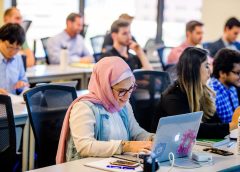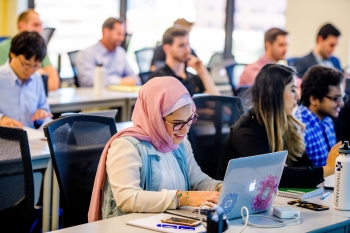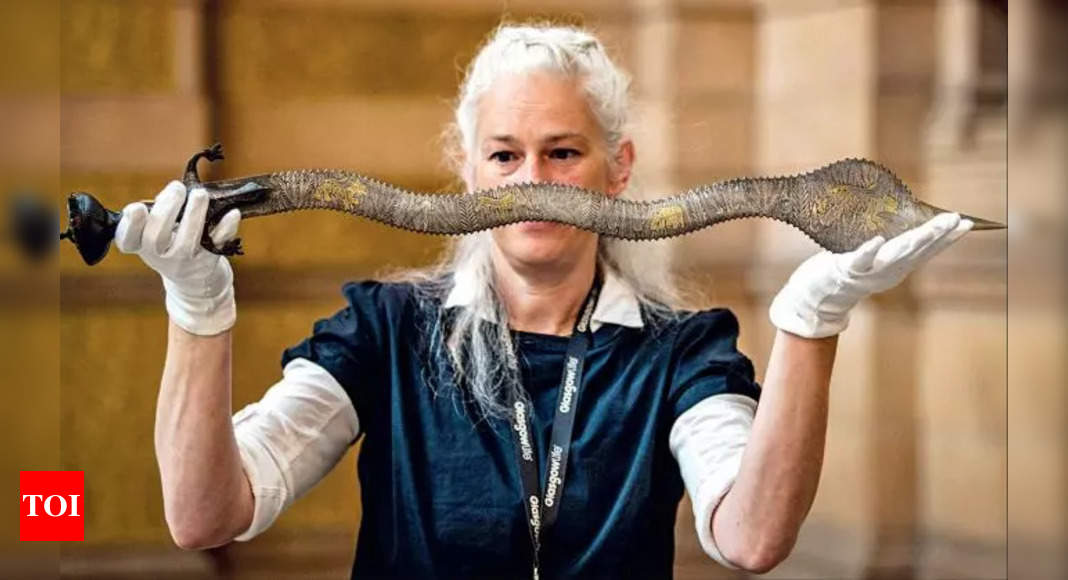
ASU faculty innovation showcases 3 tech-enabled learning experiences
[ad_1]
Technology offers new ways to enhance how we learn, work and live, and in keeping with Arizona State University’s philosophy of expanding opportunities with tech, faculty across the university are integrating tools that elevate teaching and learning.
At ASU, the University Technology Office’s (UTO) Learning Experience team assists with the integration of software and other technology into course design.

Download Full Image
“Working with faculty is essential to truly understand what both faculty and students need to have the best possible learning experience when using technology in the classroom,” said Allison Hall, Learning Experience design director.
With the start of the fall 2022 semester, UTO caught up with ASU faculty to explore how they enhance the learning experience, sharing examples and strategies for leveraging new tools.
Three standout examples — in the realms of online community building, improved web accessibility and creative tools — are full of promise for the new semester.
Building communities for ASU teaching assistants
The role of the teaching assistant (known as a TA) is long standing, with these individuals having a university experience as both student and teacher. As such, TAs operate in a number of communities and have a need to communicate effectively and inclusively.
Groups around campus are using Slack to augment community building online. The real-time communication tool has been stood up as ASU’s enterprisewide, flexible collaboration platform. Faculty and staff have been innovating with this technology since it was introduced to the university in 2019, and Cara Sidman, clinical assistant professor at the College of Health Solutions, was an early adopter.
“I love exploring new technology, so it started with that, but it also came from necessity because I needed quicker communications with my TAs in the large online courses I teach,” Sidman said. Across those ASU Online courses, Sidman can have up to 1,200 students a year, with 20 TAs at any given time.
She turned to Slack because, as she put it, “we need to communicate like an organization.” Slack’s place in the workforce also inspired Sidman to provide experience with it to student TAs.
“It’s preparing career-readiness skills, and that’s what drives a lot of my decision-making and curriculum,” she said.
Sidman notes that the Slack workspace for the TAs allows them to collaborate in course administration. One example is the use of a channel dedicated to grading, where TAs can clarify approaches to rubrics for each other and involve the instructor if necessary.
TAs also orchestrate their own “mini-communities” with students. Using Slack to create plans and trade information on best practices, they then bring discussion to spaces students are familiar with, such as in Canvas, ASU’s learning management system (LMS). “That creates a connection as well, especially for online students where we don’t see each other in person.”
Web accessibility supports learning for all
Nearly every ASU student interacts with Canvas on a regular basis. And today, a growing and important effort around course design is web accessibility, an inclusive aspect that is meant to prevent barriers for people of all abilities from interacting with the internet.
For example, Canvas’ built-in web accessibility checker scans for alt text, which is a text field added to images that will describe them for screen readers. Additionally, the ability to seek out contrast and visibility issues in images tagged PDFs and more are part of the functionality. But to enrich and support accessibility goals, a tool called Ally is available for faculty to integrate into Canvas courses.
Ally provides an intuitive dashboard that breaks down accessibility concerns by assigning scores to a course’s webpage, tagging specific issues. Instructors can view all elements of a specific web accessibility concern, such as alt text, that need to be remedied.
Through teaching disability courses and using Ally, School of Social Transformation Instructor Terri Hlava has made adjustments to her materials that make a significant impact for those who need it.
Hlava ensures all videos have transcriptions and closed captioning and text uses headers to support screen readers.
“In the spirit of inclusivity, that’s just what you do,” Hlava said.
Holly Basteyns, an instructional designer at the School of Life Sciences, said her team wants to also bring web accessibility mindfulness to students themselves. For example, it’s important for learners in Canvas courses to create accessible materials themselves.
Incorporating creative tool sets for learning
Instructors are also finding new ways to accommodate or encourage different learning styles, and the rise of multimedia is providing new learning experiences that reflect the kind of content today’s learners engage with most. To that end, Adobe Creative Cloud is being utilized by a number of faculty and students.
After taking a Digital Fluency Creative course hosted by UTO’s Learning Experience last semester, Karla Murphy and Chelsie Schlesinger, co-instructors at the School of Humanities, Arts and Cultural Studies, are continuing to find new ways to leverage Adobe’s suite of tools.
In ENG 205, for example, students are tasked to make a two-part podcast using Adobe Premiere Rush. This “literacy narrative” assignment has learners bring autobiographical experiences with aspects of literacy, such as speaking, writing, reading, rhetoric and more, to life. In ENG 102, students have a multimodal choice between a podcast or social media campaign visuals, designing graphics in Adobe Express in the latter case.
These projects don’t replace skills learned with traditional essay assignments, but “support the history that’s already there for digital literacy,” Schlesinger said. “This literacy narrative becomes a really useful tool for students with perhaps a language barrier.”
[ad_2]
Source link


